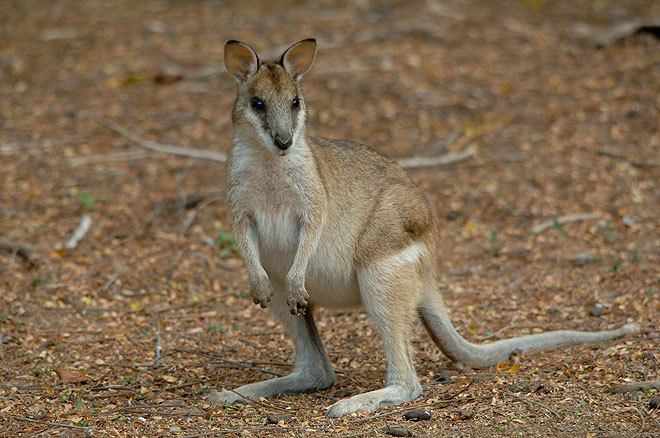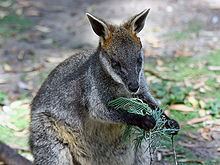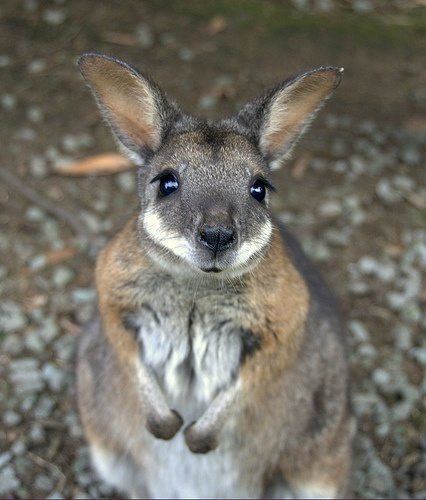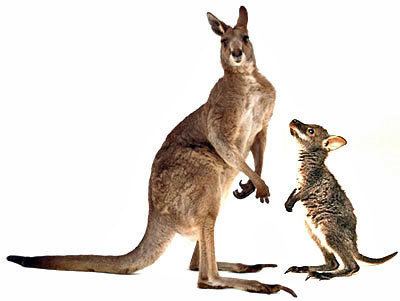Infraclass Marsupialia Kingdom Animalia Phylum Chordata | Family Macropodidae; (in part) Class Mammalia Order Diprotodontia | |
 | ||
A wallaby is a small- or mid-sized macropod found in Australia and New Guinea. They belong to the same taxonomic family as kangaroos and sometimes the same genus, but kangaroos are specifically categorised into the six largest species of the family. The term wallaby is an informal designation generally used for any macropod that is smaller than a kangaroo or wallaroo that has not been designated otherwise.
Contents
- Friendly wallaby
- Etymology and terminology
- General description
- Diet
- Threats
- Classification
- Natural range and habitat
- Introduced populations
- Species
- References

There are 11 species of brush wallabies (g. Macropus, s.g. Protemnodon). Their head and body length is 45 to 105 cm and the tail is 33 to 75 cm long. The six named species of rock-wallabies (g. Petrogale) live among rocks, usually near water; two species are endangered. The two species of hare-wallabies (g. Lagorchestes) are small animals that have the movements and some of the habits of hares. Often called "pademelons", the three species of scrub wallabies (g. Thylogale) of New Guinea, the Bismarck Archipelago, and Tasmania are small and stocky, with short hind limbs and pointed noses. They are hunted for meat and fur. A similar species is the short-tailed scrub wallaby, or quokka (Setonix brachyurus); this species is now restricted to two offshore islands of Western Australia. The three named species of forest wallabies (g. Dorcopsulus) are native to the island of New Guinea. The dwarf wallaby is the smallest member of the genus and the smallest known member of the kangaroo family. Its length is about 46 cm from nose to tail, and it weighs about 1.6 kg.

Friendly wallaby
Etymology and terminology
The name "wallaby" comes from Dharug 'walabi' or 'waliba'.
Young wallabies are known as "joeys", like many other marsupials. Adult male wallabies are referred to as "bucks", "boomers", or "jacks". An adult female wallaby is known as a "doe", "flyer", or "jill". A group of wallabies is called a "court", "mob", or "troupe". Forest-dwelling wallabies are known as "pademelons" (genus Thylogale) and "dorcopsises" (genera Dorcopsis and Dorcopsulus).
General description

Although members of most wallaby species are small, some can grow up to approximately two metres in length (from head to end of tail). Their powerful hind legs are not only used for bounding at high speeds and jumping great heights, but also to administer vigorous kicks to fend off potential predators. The Tammar wallaby (Macropus eugenii) has elastic storage in the ankle extensor tendons, without which the animal’s metabolic rate might be 30–50% greater. It has also been found that the design of spring-like tendon energy savings and economical muscle force generation is key for the two distal muscle–tendon units of the Tammar wallaby (Macropus-Eugenii). Wallabies also have a powerful tail that is used mostly for balance and support.
Diet

Wallabies are herbivores whose diet consists of a wide range of grasses, vegetables, leaves and other foliage. Due to recent urbanization, many wallabies now feed in rural and urban areas. Wallabies cover vast distances for food and water, which is often scarce in their environment. Mobs of wallabies often congregate around the same water hole during the dry season.
Threats

Wallabies face several threats. Wild dogs, foxes, and feral cats are among their predators. Humans also pose a significant threat to wallabies due to increased interaction (wallabies can defend themselves with hard kicks, and biting). Many wallabies have been involved in vehicular accidents as they often feed near roads and urban areas.
Classification

Wallabies are not a distinct genetic group. Nevertheless, they fall into several broad categories. Typical wallabies of the genus Macropus, like the agile wallaby (Macropus agilis), and the red-necked wallaby (Macropus rufogriseus) are most closely related to the kangaroos and wallaroos and, size aside, look very similar. These are the ones most frequently seen, particularly in the southern states.
Rock-wallabies (genus Petrogale), rather like the goats of the northern hemisphere, specialise in rugged terrain and have modified feet adapted to grip rock with skin friction rather than dig into soil with large claws. There are at least fifteen species and the relationship between several of them is poorly understood. Several are endangered. Captive rock wallaby breeding programs like the one at Healesville Sanctuary have had some success and a small number have recently been released into the wild.
The banded hare-wallaby (Lagostrophus fasciatus) is thought to be the last remaining member of the once-numerous subfamily Sthenurinae, and although once common across southern Australia, is now restricted to two islands off the Western Australian coast which are free of introduced predators. It is not as closely related to the other hare wallabies (genus Lagorchestes) as the hare wallabies are to the other wallabies.
New Guinea, which was until fairly recent geological times part of mainland Australia, has at least five species of wallaby.
Natural range and habitat
Wallabies are widely distributed across Australia, particularly in more remote, heavily timbered, or rugged areas, less so on the great semi-arid plains that are better suited to the larger, leaner, and more fleet-footed kangaroos. They also can be found on the island of New Guinea.
Introduced populations
Wallabies of several species have been introduced to other parts of the world, and there are a number of breeding feral populations, including:
Species
The term "wallaby" is not well defined and can mean any macropod of moderate or small size. Therefore, the listing below is arbitrary and taken from the complete list of macropods.
Genus Macropus
Genus Petrogale
Genus Lagostrophus
Genus Dorcopsis
Genus Onychogalea
Genus Thylogale
Genus Dorcopsulus
Genus Wallabia
